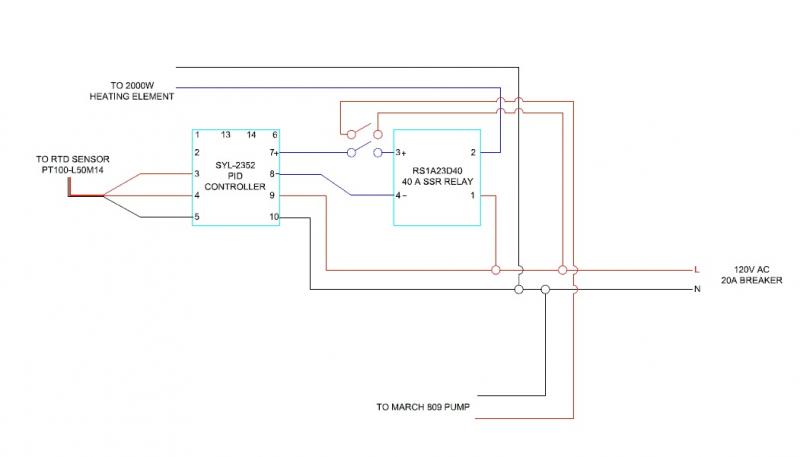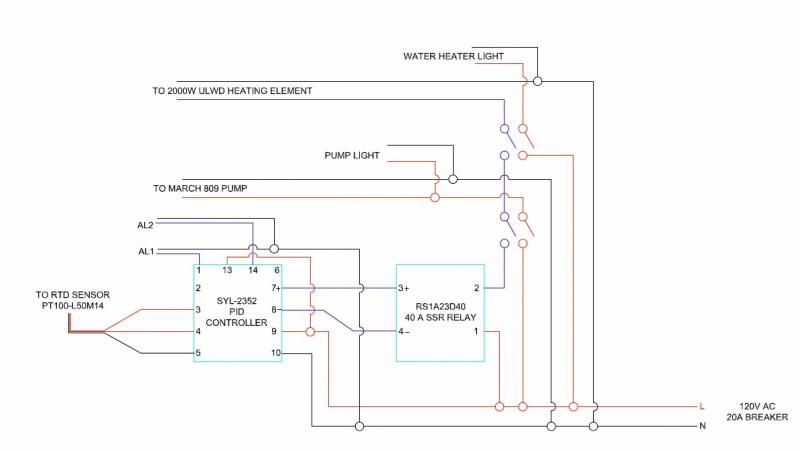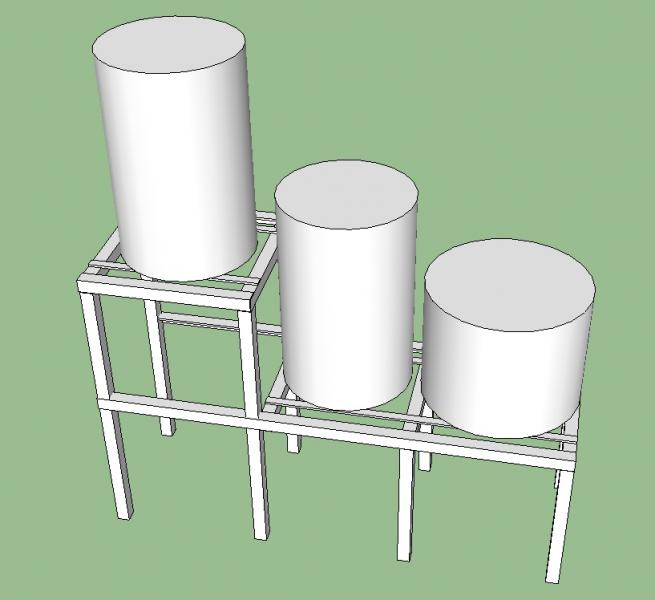JJzeJetplane
Active Member
Ok, so I'm ready to start upgrading my piecemeal all grain system to something a bit more automated. I like the idea of a RIMS system so that I can better control the entire process so that duplicating that amazing brew I come up with one day will be a cinch. I also am excited to be able to start incorporating step mashes in my brewing repertoire. Here is how the equipment will be set up.
The mash tun is equipped with a 1/2" NPT ball valve. A hose then connects this to my March 815 pump. From the pump, there is a tee and a ball valve on each output of that tee, one for the recirculating and another to go to the boil kettle. The recirculating output will then run past a thermocouple to precisely control the temperature. This will control the inline water heater that directly follows. From the water heater, it will then enter another tee, one end of which will have another ball valve and be hooked up to my hot liquor tank. The other end will reenter the mash tun and flow through the sparge arm.
Once I am ready to sparge, I will open the ball valve between the pump and the boil kettle and close the one to the inline heater. Then I will open the ball valve between the hot liquor tank and the sparge arm. NOTE, there isn't a ball valve directly between the water heater and the tee that the sparge water is being supplied, but the first one down the line between the pump and the water heater will prevent any flow in this direction. I think this pretty much sums up the system. Also, I have a kegging system and my plan to control the flow is to put the hot liquor in one of my kegs and regulate the pressure on the keg to control the flow of the sparge water.
Now comes the point that I am having difficulty in design, as I'm not inclined with electrical engineering. My intention is to have two switches control two outlets. Switch/Outlet 1 will turn the pump on and off. The second will turn the temperature controller on as well as the water heater (unless of course the controller is satisfied by a sufficient return temperature and in turn shuts the heater off). To supply the outlets, I want to wire a standard plug to plug into my back porch GFI outlet (120V, 20A). If anyone sees any flaw in my logic, I would appreciate any feedback. If everything seems sound, then I would love it if someone could draw me a wiring diagram or send me a link to an existing one. Also, let me know if I need any level of protection (GFI?) for the outlet that I am directly connecting my equipment to.
If this works, I will be more than happy to draft up plans for anyone to follow that wants to try this out.
Thanks in advance for whoever could help me.
The mash tun is equipped with a 1/2" NPT ball valve. A hose then connects this to my March 815 pump. From the pump, there is a tee and a ball valve on each output of that tee, one for the recirculating and another to go to the boil kettle. The recirculating output will then run past a thermocouple to precisely control the temperature. This will control the inline water heater that directly follows. From the water heater, it will then enter another tee, one end of which will have another ball valve and be hooked up to my hot liquor tank. The other end will reenter the mash tun and flow through the sparge arm.
Once I am ready to sparge, I will open the ball valve between the pump and the boil kettle and close the one to the inline heater. Then I will open the ball valve between the hot liquor tank and the sparge arm. NOTE, there isn't a ball valve directly between the water heater and the tee that the sparge water is being supplied, but the first one down the line between the pump and the water heater will prevent any flow in this direction. I think this pretty much sums up the system. Also, I have a kegging system and my plan to control the flow is to put the hot liquor in one of my kegs and regulate the pressure on the keg to control the flow of the sparge water.
Now comes the point that I am having difficulty in design, as I'm not inclined with electrical engineering. My intention is to have two switches control two outlets. Switch/Outlet 1 will turn the pump on and off. The second will turn the temperature controller on as well as the water heater (unless of course the controller is satisfied by a sufficient return temperature and in turn shuts the heater off). To supply the outlets, I want to wire a standard plug to plug into my back porch GFI outlet (120V, 20A). If anyone sees any flaw in my logic, I would appreciate any feedback. If everything seems sound, then I would love it if someone could draw me a wiring diagram or send me a link to an existing one. Also, let me know if I need any level of protection (GFI?) for the outlet that I am directly connecting my equipment to.
If this works, I will be more than happy to draft up plans for anyone to follow that wants to try this out.
Thanks in advance for whoever could help me.












